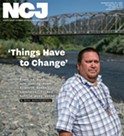
Photo by Martin do Nascimento/CalMatters
The Klamath River flows outside of Happy Camp on Aug. 29.
[
{
"name": "Top Stories Video Pair",
"insertPoint": "7",
"component": "17087298",
"parentWrapperClass": "fdn-ads-inline-content-block",
"requiredCountToDisplay": "1"
}
]
The Klamath River begins in Oregon, draining the eastern slope of the Cascade Mountains, and slices through the northwestern corner of California before flowing into the Pacific Ocean.
The Colorado River begins in Colorado, at the Continental Divide in the Rocky Mountains, before meandering southwesterly and emptying into Mexico's Sea of Cortez — if there's any water left after California and other states have tapped the river for irrigation and municipal supplies.
Although hundreds of miles apart, the two rivers share a common malady: So much of their waters were impounded or diverted that they became unhealthy.
The two rivers also share something else: Taxpayers, rather than those who manipulated the rivers for profit, are footing the bill for restoring their flows.
After decades of debate and negotiation, work has just begun to dismantle the first of four hydropower dams that plug the Klamath and block migration of salmon, steelhead and other species. One of the dams is more than a century old.
The dams' owner, PacificCorp, initially said it would seek relicensing of the four dams. But amid fierce opposition from environmentalists, fishermen (and women) and Native American tribes, and after billionaire Warren Buffett acquired the company, it agreed to remove them.
It's unlikely that the dams could have been relicensed, given their age and the opposition, so the company's posture was probably a bluff, but one that worked. After Buffett bought PacificCorp in 2005, his close friend, then-Gov. Arnold Schwarzenegger, persuaded the Legislature to set aside $250 million in state bond funds ($500 million with interest) to underwrite removal.
PacificCorp is providing about $215 million while Oregon, the primary user of the dams' hydropower, is providing just a few million dollars. Why California taxpayers should provide such a huge share of removal costs remains an unanswered question.
Last month, once again after protracted and often acrid negotiations, the federal Bureau of Reclamation announced a multi-state deal to reduce water diversions from the Colorado River by some 3 million acre-feet over the next three years, thereby staving off a crisis that threatens the viability of two immense upstream reservoirs, Lake Mead and Lake Powell.
Three-fourths of the reduction would be underwritten by more than $1 billion in federal payments to diverters in Arizona, Nevada and California, while the remainder would be uncompensated voluntary cuts.
The Imperial Irrigation District, in California's southeastern corner, is the largest diverter, with a legal right to more than 3 million acre-feet of water a year, and thus will receive a large chunk of the federal money. Not surprisingly, the district praised the new agreement.
The deal was reached after the Bureau of Reclamation threatened to impose cuts on Imperial and other diverters to prevent the two reservoirs from becoming inoperable due to years of drought.
"California has stepped up to make significant cuts to water usage and now, this historic partnership between California and other Lower Basin states will help maintain critical water supply for millions of Americans as we work together to ensure the long-term sustainability of the Colorado River System for decades to come," Gov. Gavin Newsom said in a statement.
While the agreement addresses the immediate crisis on the Colorado, the many stakeholders will also be negotiating a supposedly permanent pact on how its water will be divvied up and Imperial and other California diverters will be seeking even more federal money to offset their losses.
Both Klamath and Colorado situations could, and probably should, have been resolved without taxpayers on the hook to compensate those whose actions had caused their problems in the first place. But, as the old saying goes, money talks while bull---- walks.
Calmatters is a nonpartisan, nonprofit newsroom dedicated to explaining California politics and policy.
More by CalMatters
-
Behind the 'No Corporate PAC' Pledge
Are California Senate candidates really swearing off corporate dollars?
- Feb 15, 2024
-
New State Laws Aimed to Streamline Home Building Take Effect in 2024
- Jan 4, 2024
-
'Things Have to Change'
Even as dams are coming down, Klamath Basin ranchers, tribes battle over water
- Dec 21, 2023
- More »
Latest in Views
Readers also liked…
-
Hope
- Sep 7, 2023
-
California Says No to Privatizing Medicare
- Sep 21, 2023































